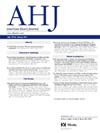Patient characteristics, presentation, causal microorganisms, and overall mortality in the NatIonal Danish endocarditis stUdieS (NIDUS) registry
IF 3.7
2区 医学
Q1 CARDIAC & CARDIOVASCULAR SYSTEMS
引用次数: 0
Abstract
Background
Most knowledge on infective endocarditis (IE) comes from large IE cohorts that include patients from tertiary hospitals, leading to referral bias and retrospective population-based studies. This highlights the need for a more detailed characterization of IE in unselected patient cohorts.
Methods
In the National Danish Endocarditis Studies (NIDUS) registry, all hospitalizations in Denmark from 2016 to 2021 with an IE diagnosis were reviewed and validated using electronic medical records (EMR) by healthcare professionals under the supervision of IE experts. Episodes meeting the European Society of Cardiology 2015 modified diagnostic criteria for possible or definite IE were included.
Results
We screened 4390 unique patients, of whom 3557 (81%) were included in the NIDUS registry. Of the 3557 unique patients, 2832 (79.6%) were classified as definite IE and 725 (20.4%) as possible IE. The age was 73.7 years, and most patients were men (68.3%). In total, 689 (19.4%) underwent surgery during hospitalization. The most frequent comorbidities were diabetes (23.7%), heart failure (18.7%), and chronic kidney disease (17.4%). Most patients presented with fever (61.1%), followed by dyspnea (33.0%) and myalgias (27.0%). Sepsis was found in 828 (23.3%) patients, while 378 (10.6%) had signs of embolization at admission. Positive blood cultures were identified in 3191 (89.7%) patients, and the most frequent microbiological etiology was Staphylococcus aureus (31.9%). The in-hospital mortality was 17.3%, and the 1-year mortality rate was 31.3%.
Conclusion
The NatIonal Danish endocarditis studies (NIDUS) registry provides comprehensive, granular, and nationwide data on a cohort of patients with infective endocarditis, revealing that when selection is not restricted to tertiary hospitals or voluntary registries, some important differences emerge. Patients with IE are on average older, have a similar burden of comorbidities, and less often undergo surgery. Minimizing selection bias with the use of a national registry provides a clearer picture of IE as it occurs in real-world clinical settings.

丹麦国家心内膜炎研究(NIDUS)登记的患者特征、表现、致病微生物和总死亡率。
背景:有关感染性心内膜炎(IE)的大多数知识都来自大型 IE 队列,其中包括来自三级医院的患者,这导致了转诊偏差和基于人群的回顾性研究。这凸显了在未选择的患者队列中对 IE 进行更详细描述的必要性:在丹麦国家心内膜炎研究(NIDUS)登记处,医护人员在 IE 专家的监督下使用电子病历(EMR)对 2016 年至 2021 年丹麦所有诊断为 IE 的住院病例进行了审查和验证。符合欧洲心脏病学会 2015 年修订的可能或明确 IE 诊断标准的病例被纳入其中:我们筛选了 4390 名患者,其中 3557 人(81%)被纳入 NIDUS 登记册。在这 3557 名患者中,有 2832 人(79.6%)被归类为明确的 IE,725 人(20.4%)被归类为可能的 IE。患者年龄为 73.7 岁,大多数为男性(68.3%)。共有 689 人(19.4%)在住院期间接受了手术。最常见的合并症是糖尿病(23.7%)、心力衰竭(18.7%)和慢性肾病(17.4%)。大多数患者伴有发热(61.1%),其次是呼吸困难(33.0%)和肌痛(27.0%)。有 828 名患者(23.3%)出现败血症,378 名患者(10.6%)入院时有栓塞迹象。3191名(89.7%)患者的血液培养呈阳性,最常见的微生物病原体是金黄色葡萄球菌(31.9%)。院内死亡率为 17.3%,一年死亡率为 31.3%:NIDUS登记提供了感染性心内膜炎患者队列的全面、详细和全国性数据,揭示了当选择范围不局限于三级医院或自愿登记时,会出现一些重要的差异。感染性心内膜炎患者的平均年龄较大,合并症的负担相似,而且较少接受手术治疗。通过使用全国性登记册来尽量减少选择偏差,可以更清楚地了解 IE 在实际临床环境中的情况。
本文章由计算机程序翻译,如有差异,请以英文原文为准。
求助全文
约1分钟内获得全文
求助全文
来源期刊

American heart journal
医学-心血管系统
CiteScore
8.20
自引率
2.10%
发文量
214
审稿时长
38 days
期刊介绍:
The American Heart Journal will consider for publication suitable articles on topics pertaining to the broad discipline of cardiovascular disease. Our goal is to provide the reader primary investigation, scholarly review, and opinion concerning the practice of cardiovascular medicine. We especially encourage submission of 3 types of reports that are not frequently seen in cardiovascular journals: negative clinical studies, reports on study designs, and studies involving the organization of medical care. The Journal does not accept individual case reports or original articles involving bench laboratory or animal research.
 求助内容:
求助内容: 应助结果提醒方式:
应助结果提醒方式:


